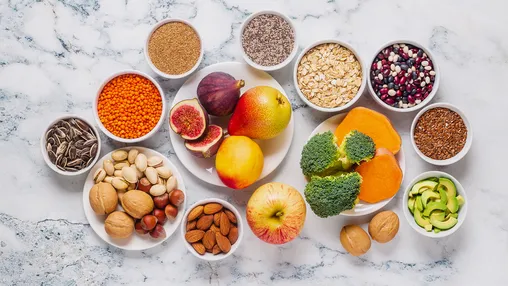Should You Try ‘Fibermaxxing’ to Transform Your Gut Health?

You may have seen people on TikTok mixing up oatmeal, tossing colorful salads, and pushing fiber supplements — all in an effort to dramatically increase their intake of fiber, an endeavor they’re calling “fibermaxxing.”
Fibermaxxing is going viral on social media. The TikTok user @impamibaby says her regular breakfast of fiber-rich chia seeds with fruit has made her bloating disappear. The nutrition brand @join_zoe recommends that people fibermax by adding more nutrient-dense foods to their diet (like throwing in peas, asparagus, and squash into a pesto pasta dish), rather than cutting things out.
“I love that fibermaxxing is gaining traction,” says Malina Malkani, RDN, a registered dietitian-nutritionist in New York City. “It’s refreshing to see a mostly positive nutrition trend going viral, and anything that encourages more whole fruits, veggies, legumes, and whole grains is a win in my book.”
This is crucial, as most Americans are fiber-deficient, “especially due to recent trends of keto and carnivore diets,” adds Jessica Smith, RD, an oncology dietitian with UC Davis Medical Center in California.
What Is Fiber?
- Soluble fiber dissolves in water and turns to gel in the digestive tract. This slows digestion, staving off hunger and lowering cholesterol.
- Insoluble fiber doesn’t dissolve in water. It helps food move through your digestive system, which can prevent constipation.
The Benefits of Fiber
Boosts Gut Health
Fiber adds bulk to your stool, preventing constipation and improving digestive regularity, says Melissa Rifkin, RD, a Connecticut-based dietitian and the owner of Melissa Rifkin Nutrition. It also supports the healthy bacteria in your intestines, which play a role in your immune system and mood, Smith says.
“The more variety we have in our diet, the more diverse our gut microbiome, which leads to a healthier and happier life,” Smith says.
Improves Metabolism and Heart Health
Helps With Weight Loss
Fiber can help you lose weight and maintain a healthy weight via a few mechanisms. One is its ability to regulate sugar in the bloodstream, which also helps balance hunger-regulating hormones, Malkani says.
“The combination of improved satiety and reduced fasting blood glucose allows fiber to be effective in weight loss goals,” Rifkin says.
The Best High-Fiber Foods
Dietitians particularly love:
- Raspberries and other types of berries
- Lentils
- Chia seeds
- Oats
- Avocados
- Sweet potatoes with the skin
- Broccoli
- Beans
- Almonds
- Whole grains
Beyond fiber, these foods also contain other essential nutrients, like unsaturated fats, protein, vitamins, minerals, and antioxidants, Rifkin says.
When You Might Need a Fiber Supplement
You should aim to boost your fiber intake via whole foods, Rifkin says. If you’re unable to meet your fiber needs from food sources, a fiber supplement can be beneficial.
Fiber supplements may also be helpful for picky eaters, individuals with food allergies, or anyone with a gastrointestinal condition who has to limit what they eat, Malkani says.
“Although fiber is an essential nutrient, you should always discuss supplements with your physician,” because they’re not appropriate for everyone, Rifkin says.
Who Should and Shouldn’t Try Fibermaxxing
Fibermaxxing is beneficial for most people, as few of us get enough fiber in our diets, Smith says.
Fiber recommendations may vary from person to person, depending on age, weight, how much you eat, and your overall health, Smith says, “so it’s important to consult your physician or registered dietitian for guidance.”
If you have a gut condition like IBS, inflammatory bowel disease, or diverticulitis, or you’ve recently had bowel surgery, you may “need a different approach to fiber,” Smith explains. “Consult your physician or registered dietitian to determine how much fiber is right for you.”
The Bottom Line on Fibermaxxing
Fibermaxxing is beneficial for most people who aren’t currently meeting their fiber needs.
“I’m thrilled to see a growing interest in adding more fiber,” Smith says. “Often, diet trends focus on removing foods, so it is refreshing to have fibermaxxing focus on adding certain foods into the diet, which is a more sustainable approach.”
- Dietary Guidelines for Americans, 2020–2025. U.S. Department of Agriculture.
- The Nutrition Source: Fiber. Harvard T.H. Chan School of Public Health. April 2022.
- Dietary fiber: Essential for a healthy diet. Mayo Clinic.

Emily Kay Votruba
Fact-Checker
.jpg?sfvrsn=fde66ffd_1)
Erica Sweeney
Author
Erica Sweeney has been a journalist for more than two decades. These days, she mostly covers health and wellness as a freelance writer. Her work regularly appears in The New York Times, Men’s Health, HuffPost, Self, and many other publications. She has a master’s degree in journalism from the University of Arkansas at Little Rock, where she previously worked in local media and still lives.